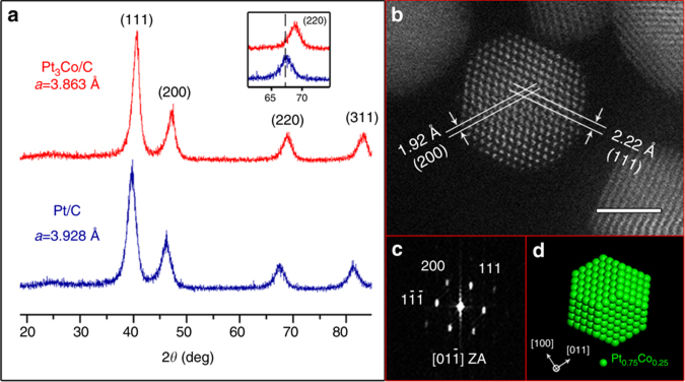当前位置:
X-MOL 学术
›
Nat. Commun.
›
论文详情
Our official English website, www.x-mol.net, welcomes your
feedback! (Note: you will need to create a separate account there.)
In situ atomic-scale observation of oxygen-driven core-shell formation in Pt3Co nanoparticles.
Nature Communications ( IF 14.7 ) Pub Date : 2017-08-07 , DOI: 10.1038/s41467-017-00161-y Sheng Dai , Yuan You , Shuyi Zhang , Wei Cai , Mingjie Xu , Lin Xie , Ruqian Wu , George W. Graham , Xiaoqing Pan
Nature Communications ( IF 14.7 ) Pub Date : 2017-08-07 , DOI: 10.1038/s41467-017-00161-y Sheng Dai , Yuan You , Shuyi Zhang , Wei Cai , Mingjie Xu , Lin Xie , Ruqian Wu , George W. Graham , Xiaoqing Pan

|
The catalytic performance of core-shell platinum alloy nanoparticles is typically superior to that of pure platinum nanoparticles for the oxygen reduction reaction in fuel cell cathodes. Thorough understanding of core-shell formation is critical for atomic-scale design and control of the platinum shell, which is known to be the structural feature responsible for the enhancement. Here we reveal details of a counter-intuitive core-shell formation process in platinum-cobalt nanoparticles at elevated temperature under oxygen at atmospheric pressure, by using advanced in situ electron microscopy. Initial segregation of a thin platinum, rather than cobalt oxide, surface layer occurs concurrently with ordering of the intermetallic core, followed by the layer-by-layer growth of a platinum shell via Ostwald ripening during the oxygen annealing treatment. Calculations based on density functional theory demonstrate that this process follows an energetically favourable path. These findings are expected to be useful for the future design of structured platinum alloy nanocatalysts.Core-shell platinum alloy nanoparticles are promising catalysts for oxygen reduction, however a deeper understanding of core-shell formation is still required. Here the authors report oxygen-driven formation of core-shell Pt3Co nanoparticles, seen at the atomic scale with in situ electron microscopy at ambient pressure.
中文翻译:

Pt3Co纳米粒子中氧驱动核壳形成的原位原子尺度观察。
对于燃料电池阴极中的氧还原反应,核-壳铂合金纳米颗粒的催化性能通常优于纯铂纳米颗粒。对核壳形成的透彻了解对于原子级设计和控制铂壳至关重要,铂壳是众所周知的结构特征。在这里,我们通过使用先进的原位电子显微镜揭示了在高温,氧气和大气压下铂-钴纳米颗粒在高温下的反直觉的核-壳形成过程的细节。薄的铂而不是氧化钴的表面层的初始偏析与金属间核的排列同时发生,然后在氧退火处理过程中通过奥斯特瓦尔德熟化逐层生长铂壳。基于密度泛函理论的计算表明,该过程遵循了一条在能量上有利的道路。这些发现有望对结构化铂合金纳米催化剂的未来设计有用。核-壳铂合金纳米颗粒是有希望的氧还原催化剂,但是仍然需要对核-壳形成有更深入的了解。在这里,作者报告了氧驱动的核-壳铂的形成3 Co纳米粒子,在环境压力下用原位电子显微镜在原子尺度上观察到。
更新日期:2017-08-07
中文翻译:

Pt3Co纳米粒子中氧驱动核壳形成的原位原子尺度观察。
对于燃料电池阴极中的氧还原反应,核-壳铂合金纳米颗粒的催化性能通常优于纯铂纳米颗粒。对核壳形成的透彻了解对于原子级设计和控制铂壳至关重要,铂壳是众所周知的结构特征。在这里,我们通过使用先进的原位电子显微镜揭示了在高温,氧气和大气压下铂-钴纳米颗粒在高温下的反直觉的核-壳形成过程的细节。薄的铂而不是氧化钴的表面层的初始偏析与金属间核的排列同时发生,然后在氧退火处理过程中通过奥斯特瓦尔德熟化逐层生长铂壳。基于密度泛函理论的计算表明,该过程遵循了一条在能量上有利的道路。这些发现有望对结构化铂合金纳米催化剂的未来设计有用。核-壳铂合金纳米颗粒是有希望的氧还原催化剂,但是仍然需要对核-壳形成有更深入的了解。在这里,作者报告了氧驱动的核-壳铂的形成3 Co纳米粒子,在环境压力下用原位电子显微镜在原子尺度上观察到。















































 京公网安备 11010802027423号
京公网安备 11010802027423号